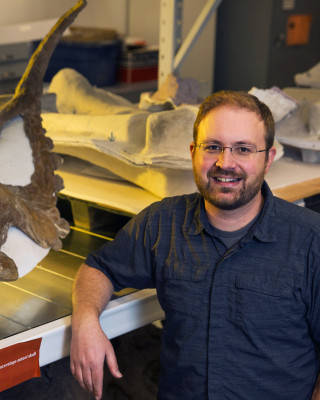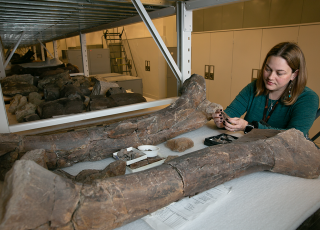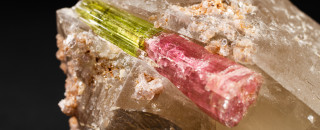
Image 5 — Bicolored elbaite on quartz from the Himalaya Mine, Mesa Grande, California. Photo by Mark Johnston
Mineralogy
NHMU’s Mineralogy Collection includes natural crystals, ore samples, and faceted gemstone specimens that illustrate the diversity and beauty of minerals. Minerals tell the story of how the interior of the earth works and, since they contain resources that we use throughout our modern lives, they are important to study from a practical perspective.
The collection comprises around 5,000 specimens, including precious metals and gems, meteorites, fluorescent crystals, and even toxic specimens. We have built this collection over time thanks to many generous donors.
Our collection is particularly strong in its representation of the great diversity of minerals found in Utah, in addition to other specimens from around the world. Some specimens are only found in Utah, such as gem-quality red beryl from Topaz Mountain. Utah’s natural richness in metal ores is reflected in the copper-clad Rio Tinto Center, the home of the Natural History Museum of Utah.
There are over 100 beautiful selections of minerals on display on the 3rd floor of the museum, where you will also find a window that peeks into our collections space, where additional storage cabinets contain mineral specimens not on display. We use our collection primarily for display and education. To that end, we are in the process of putting our mineral specimen database online, open to all.
Did you know...
The museum's mineralogy collections include exceptionally rare minerals, such as gem-quality red beryl from western Utah.
Mineralogy Collection Highlights
-
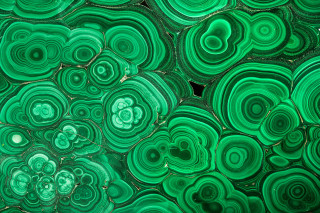
Malachite
This beautiful bright green mineral is called malachite (Cu2CO3(OH)2) and is from Katanga Province in the Democratic Republic of the Congo. It is a copper carbonate hydroxide mineral and is one of the major ores mined to produce copper. Because of its brilliant green color, it is a popular carving medium for artists and jewelers.
Catalog #: UMNH.MC.0069R
-
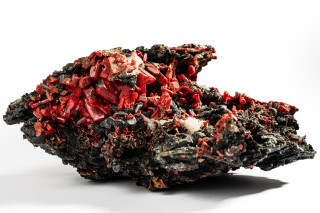
Realgar
This vibrant mineral association contains red realgar (α-As4S4), white calcite (CaCO3), on black volcanic rock. Realgar, is also referred to as “ruby sulfur” or “ruby of arsenic” as it contains both elements. As you can imagine, with these components, realgar is toxic to humans, rodents, insects, and many plants. The name Realgar comes from the Arabic ‘rahj al-gar’ meaning ‘powder of the mine.’ This specimen is from Humbolt County, Nevada.
Catalog #: UMNH.MC.1242
-
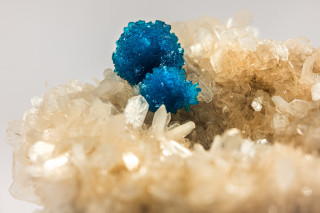
Cavansite on Stilbite
These blue cavansite (Ca(VO)Si4O10 · 4(H2O)) crystals on top of white stilbite (NaCa4(Si27Al9)O72 · 28(H2O)) are a brilliant mineral association. The deep-blue color of the delicate ball-shaped cavansite comes from trace amounts of vanadium in the crystal lattice. This specimen was found in India.
Catalog #: UMNH.MC.3259
-
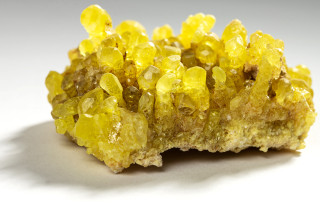
Sulfur
Sulfur (S) is both an element and a mineral. It is bright lemon yellow and has a characteristic rotten eggs smell. In historic literature, it was referred to as brimstone, or burning stone, which might refer to its unique smell. It is used in the production of sulfuric acid, batteries, fertilizers, and cleaners. The globule microcrystals you see here were formed under extreme pressure or heat without melting.
Catalog #: UMNH.MC.0230
-
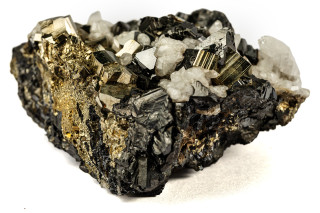
Sphalerite, Pyrite, and Calcite
This specimen was found in Salt Lake County and shows off three different minerals that commonly co-occur in copper porphyry deposits such as the Kennecott Mine. The black mineral is sphalerite (Zn,Fe)S, the gold mineral is pyrite (FeS2), and the white mineral is calcite (CaCO3). Two of these minerals are tricksters; sphalerite comes from the Greek “sphaleros” meaning “deceiving,” alluding to its challenging identification, and pyrite is commonly referred to as “fool’s gold.”
Catalog #: UMNH.MC.2438
-
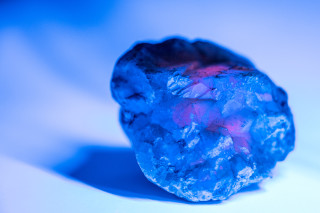
White Calcite
Upon first glance, this white calcite (CaCO3) from Utah might look boring. However, when exposed to ultraviolet light, these crystals fluoresce in neon blue and red! This mineral has the ability to temporarily absorb UV light, then give off light in the visible spectrum, making the mineral appear to glow in the dark.
Catalog #: UMNH.MC.2931
-
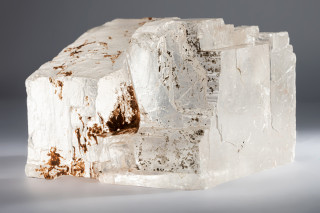
Halite
This specimen of Halite (NaCl) is from the Great Salt Lake, in Utah. Inland saline lakes, where water is evaporating, leave large salt deposits. Halite is the natural form of salt, where crystals occur as cubes. It is often transparent. And, of course, if you lick it, it tastes, well you know, salty! This common mineral also fluoresces (“glows in the dark”) a red color when exposed to ultraviolet light.
Catalog #: UMNH.MC.2788
-
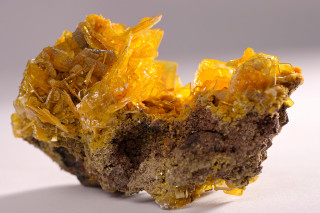
Wulfenite
This fragile, bright yellow mineral is called wulfenite (PbMoO4). This lead molybdate minerals come from Mexico. It has iconic bright transparent bladed crystals in a tetragonal system. It gets its yellow color from small traces of chromium. Wulfenite occurs in hydrothermal deposits of lead and molybdenum.
Catalog #: UMNH.MC.0149R
-
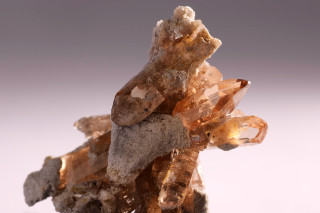
Topaz
If you are a rockhound from Utah, you have heard of Topaz Mountain. The semiprecious mineral topaz (Al2SiO4(F,OH)2) is Utah’s state gem, and the crystals found at Topaz Mountain are amber in color. One thing to keep in mind is that the color fades with exposure to sunlight. So, if you plan to try your luck yourself, be sure to keep what you find in a dark place.
Catalog #: UMNH. MC.4193
-
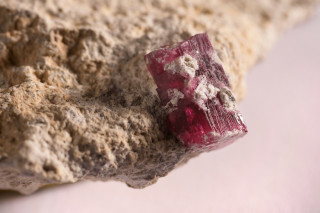
Red Beryl
What is worth more than gold and rarer than diamonds? Why, red beryl, of course! This raspberry-colored red beryl (Be3Al2Si6O18) specimen is actually from Juab County in Utah. Red Beryl is only found in a handful of sites in Utah and one place in New Mexico. Rare indeed! With its origin being volcanic vents, red beryl crystals are formed under low pressure and high temperature.
Catalog #: UMNH.MC.0350R
-
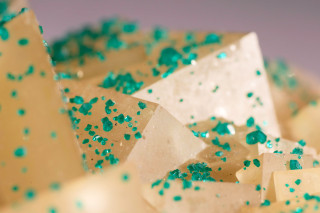
Dioptase on Calcite
If this specimen reminds you of sprinkles on top of a cupcake, you are not the only one. This stunning mineral association is brilliant green dioptase (Cu6Si6O18·6H2O) that crystalized on top of cubes of clear/white calcite (CaCO3). The fragile emerald green Dioptase is a copper cyclosilicate mineral that forms in arid regions where copper sulfides become oxidized. This specimen was found at Tsemeb, in Namibia, southwestern Africa.
Catalog #: UMNH.MC.0262
1 of 11
Mineralogy Research Staff
-
Carrie Levitt-Bussian
Paleontology & Mineralogy Collections Manager
-
